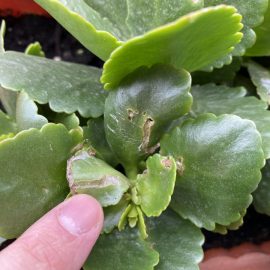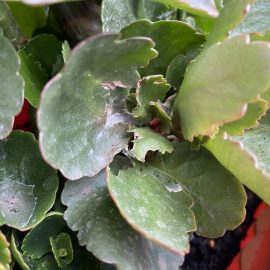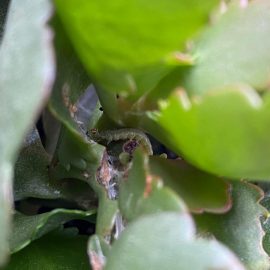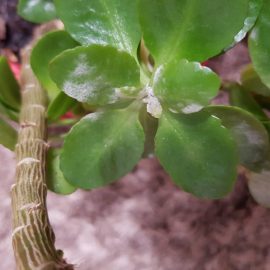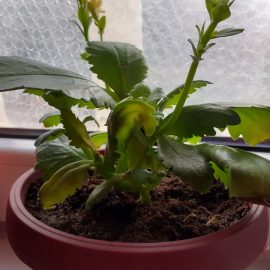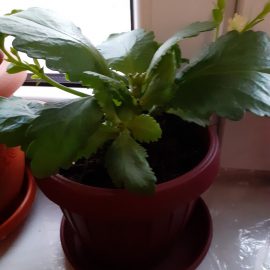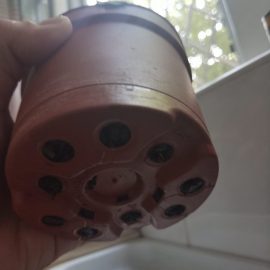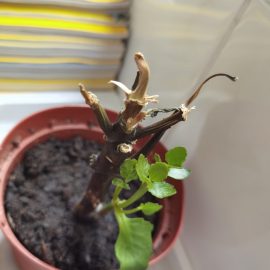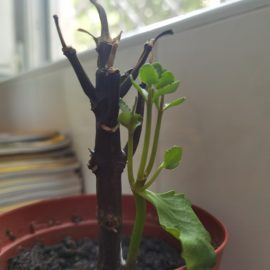Kalanchoe, plant care and growing guide
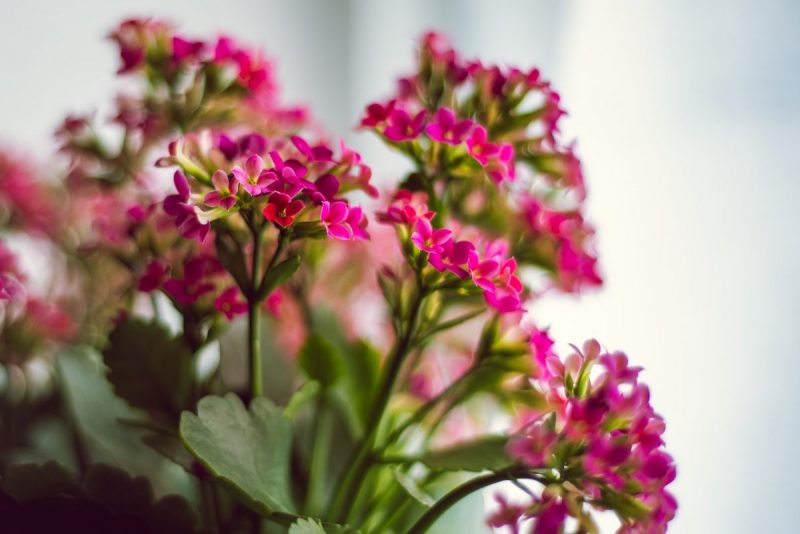
Kalanchoe spp. is a genus of succulent, tropical plants native to Madagascar and the tropics of Africa. They look like shrubs and bloom for a long time, having flowers colored in red, yellow, pink, or orange. Some species are perennial and others are annual or biennial.
Species
Kalanchoe blossfeldiana has a height of up to 20-30 cm. It is a perennial plant that grows in the form of a bush. It has succulent, glossy leaves that remain green all year round. It has an alternate leaf arrangement. The leaves are simple, have an oblong shape, and have crenate edges. The flowers consist of 4 or more petals, their base forming a short tube. The buds do not open at the same time, so it has a prolonged flowering period.
Kalanchoe Tessa reaches up to 30 cm in height, grows in hanging planters, and has droopy stems with oval leaves and bell-shaped tubular flowers. It generally blooms in early spring, and the flowers (red, or orange) last for a few weeks.
Kalanchoe daigremontiana, also called “Mexican hat”, has green-gray leaves, sharp or rounded. It is distinguished through the fact that small seedlings grow on the edge of the leaves, with a role in the propagation of the plant.
Kalanchoe tubiflora (K. delagoensis) has a straight stem, from which slightly cylindrical leaves sprout, with brown spots. Small seedlings also grow towards the edge of the leaves.
Kalanchoe beharensis has triangular leaves, large, thick, olive-green, with crenated edges. The base of the leaves is smooth and glossy, covered with a fine fuzz. The surface of the leaves is concave.
Kalanchoe fedtschenkoi has the shape of a bush, branched and creeping. It has round, smooth, and soft stems, on which flat, gray-blue leaves are attached. The leaves are arranged alternately, are fleshy, and have crenate edges. Sometimes, the edges can get a red or pink tint, depending on the temperature and sun exposure. It blooms abundantly, the inflorescences being pendant, with a tubular shape, red, coral, or orange.
Kalanchoe longiflora has orange leaves. It blooms in autumn, towards winter, and the flowers are yellow.
Kalanchoe rubinea has leaves with crenated edges, with a red shade.
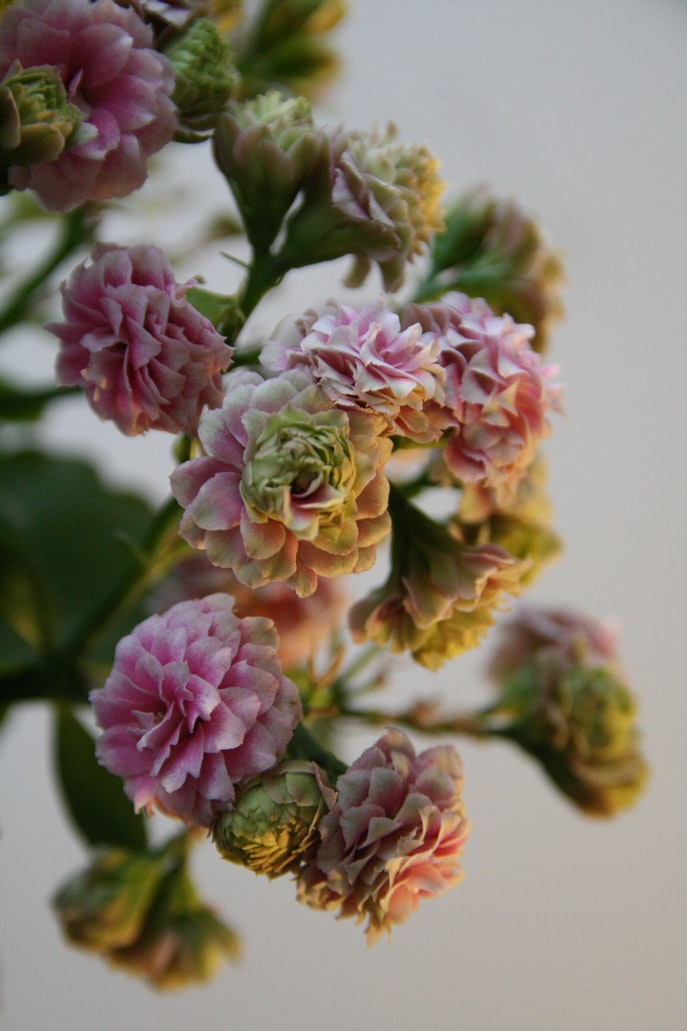
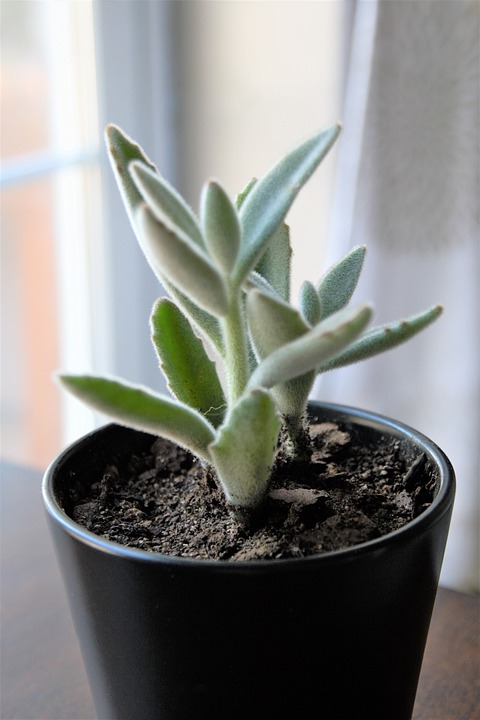
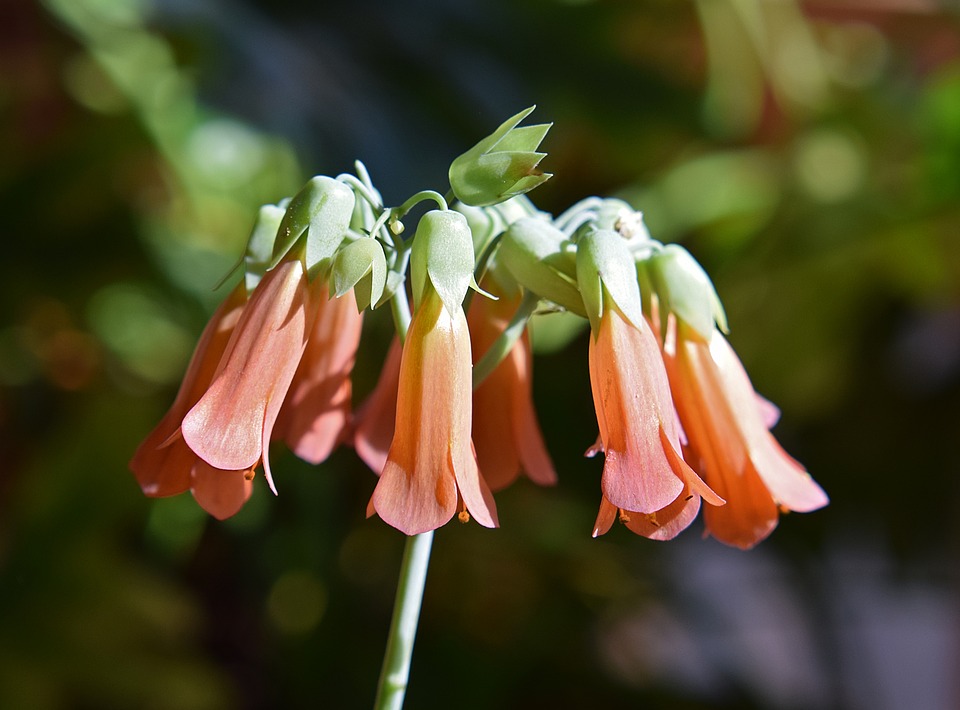
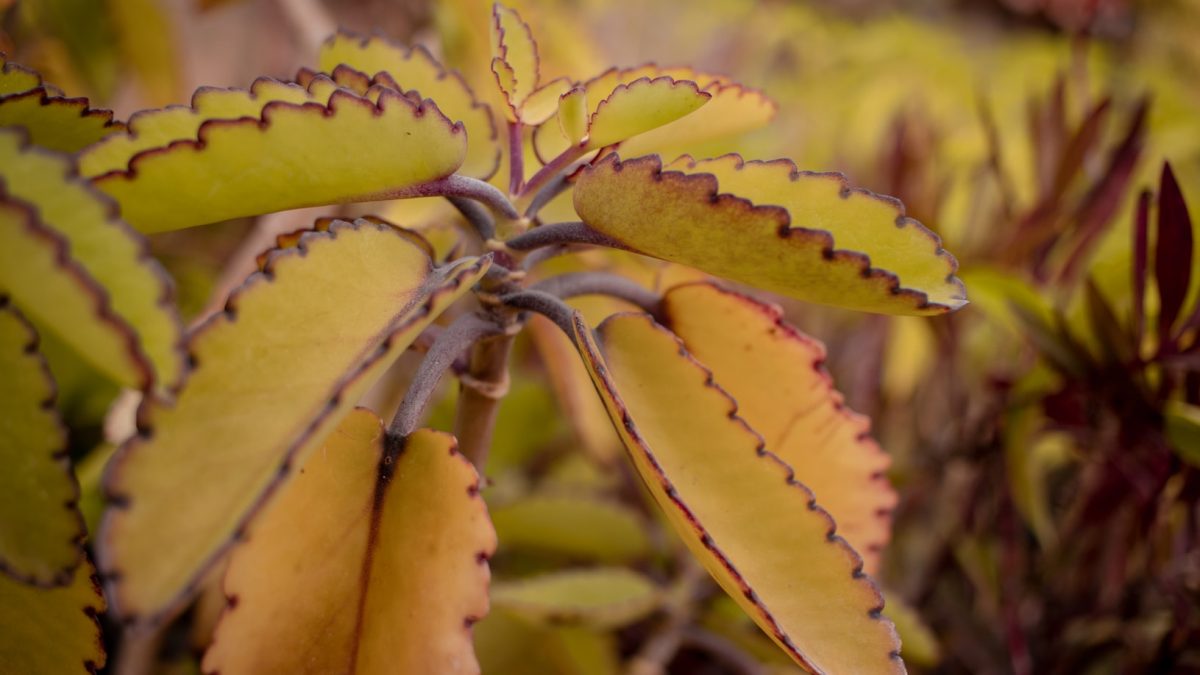
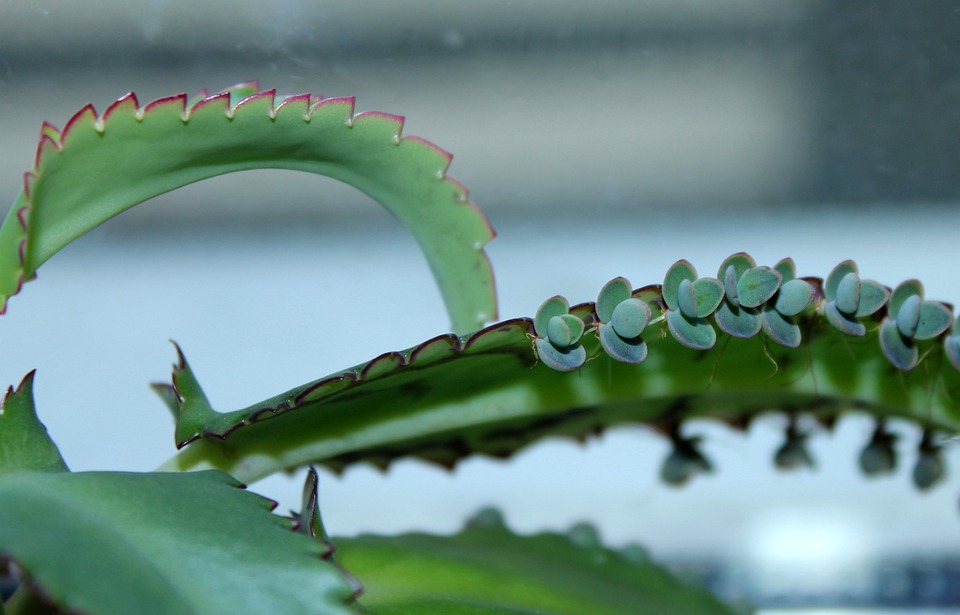
Light. Kalanchoe needs strong light to grow and produce flowers. It should be placed in the sun, but only if the sun rays are not too strong. The strong sun can cause the leaves to turn red or dry. The lack of light leads to slow growth and a decrease in the number of shoots.
Temperature. The optimum growth temperature is 20-24º C. It is a plant very sensitive to low temperatures, and it can be severely affected by temperatures below 10° C.
Humidity. It likes normal humidity. The room in which they are kept must be well ventilated because high humidity and stale air can cause fungal diseases. In summer, when temperatures are high and the air is dry, the leaves can be sprayed with non-calcareous water.
Substrate. The substrate for Kalanchoe must have a porous structure, to avoid water stagnation and to favor the circulation of air and water towards the roots. It can be made of Geranium soil or garden soil, to which sand or gravel must be added to improve drainage. The optimal pH of the substrate is between 6-7. An alkaline pH causes the leaves to turn yellow, while an acidic pH causes the leaves to turn brown.
Recommended products
-
You can find products on a different store
Change Store -
You can find products on a different store
Change Store -
You can find products on a different store
Change Store -
You can find products on a different store
Change Store -
You can find products on a different store
Change Store -
You can find products on a different store
Change Store -
You can find products on a different store
Change Store -
You can find products on a different store
Change Store -
You can find products on a different store
Change Store -
You can find products on a different store
Change Store -
You can find products on a different store
Change Store -
You can find products on a different store
Change Store -
You can find products on a different store
Change Store -
You can find products on a different store
Change Store -
You can find products on a different store
Change Store -
You can find products on a different store
Change Store -
You can find products on a different store
Change Store -
You can find products on a different store
Change Store -
You can find products on a different store
Change Store -
You can find products on a different store
Change Store -
You can find products on a different store
Change Store -
You can find products on a different store
Change Store -
You can find products on a different store
Change Store -
You can find products on a different store
Change Store
Watering
From spring to mid-autumn (during the period of active growth and flowering), it should be watered once or twice a week, depending on the substrate. It is recommended to add water in small quantities when the substrate is dry on the surface. During the winter months, the plant should be watered every 15-30 days, but the substrate should not be allowed to dry completely.
Fertilization. If the plants are already in bloom, use special fertilizer for flowering plants. For species that have only leaves, you can use a fertilizer for cacti and succulents. The fertilizer should be administered only during the period of growth and flowering, monthly, from April to October.
Recommended products
-
You can find products on a different store
Change Store -
You can find products on a different store
Change Store -
You can find products on a different store
Change Store -
You can find products on a different store
Change Store -
You can find products on a different store
Change Store -
You can find products on a different store
Change Store -
You can find products on a different store
Change Store -
You can find products on a different store
Change Store -
You can find products on a different store
Change Store -
You can find products on a different store
Change Store -
You can find products on a different store
Change Store -
You can find products on a different store
Change Store -
You can find products on a different store
Change Store -
You can find products on a different store
Change Store -
You can find products on a different store
Change Store -
You can find products on a different store
Change Store -
You can find products on a different store
Change Store -
You can find products on a different store
Change Store -
You can find products on a different store
Change Store -
You can find products on a different store
Change Store -
You can find products on a different store
Change Store -
You can find products on a different store
Change Store -
You can find products on a different store
Change Store -
You can find products on a different store
Change Store
Repotting. Transplanting Kalanchoe species with strong growth should be done once a year. It is recommended to choose a larger pot, taking into account the plant’s size.
Propagation
It can be propagated through small seedlings that grow on the edge of the leaves (in some species). Planted in a pot, not too deep, they produce roots quickly.
They can also be propagated through cuttings (stem segments) with a length of 9-10 cm. After removing the cuttings, it is recommended to let them heal for 1-2 days. The optimum temperature for rooting is 21º C. In this case and if proper humidity is ensured, the cuttings should be rooted in 2-3 weeks. To stimulate the process of root formation, rooting stimulators can be added.
Recommended products
-
You can find products on a different store
Change Store -
You can find products on a different store
Change Store -
You can find products on a different store
Change Store -
You can find products on a different store
Change Store -
You can find products on a different store
Change Store -
You can find products on a different store
Change Store -
You can find products on a different store
Change Store -
You can find products on a different store
Change Store -
You can find products on a different store
Change Store -
You can find products on a different store
Change Store -
You can find products on a different store
Change Store -
You can find products on a different store
Change Store -
You can find products on a different store
Change Store -
You can find products on a different store
Change Store -
You can find products on a different store
Change Store -
You can find products on a different store
Change Store -
You can find products on a different store
Change Store -
You can find products on a different store
Change Store -
You can find products on a different store
Change Store -
You can find products on a different store
Change Store -
You can find products on a different store
Change Store -
You can find products on a different store
Change Store -
You can find products on a different store
Change Store -
You can find products on a different store
Change Store
It can also be propagated through seeds, which germinate at constant temperatures of 21-22º C.
Recommended products
-
You can find products on a different store
Change Store -
You can find products on a different store
Change Store -
You can find products on a different store
Change Store -
You can find products on a different store
Change Store -
You can find products on a different store
Change Store -
You can find products on a different store
Change Store -
You can find products on a different store
Change Store -
You can find products on a different store
Change Store -
You can find products on a different store
Change Store -
You can find products on a different store
Change Store -
You can find products on a different store
Change Store -
You can find products on a different store
Change Store -
You can find products on a different store
Change Store -
You can find products on a different store
Change Store -
You can find products on a different store
Change Store -
You can find products on a different store
Change Store -
You can find products on a different store
Change Store -
You can find products on a different store
Change Store -
You can find products on a different store
Change Store -
You can find products on a different store
Change Store -
You can find products on a different store
Change Store -
You can find products on a different store
Change Store -
You can find products on a different store
Change Store -
You can find products on a different store
Change Store
Diseases and pests. Powdery mildew and Black spot can occur in flowering species, caused by improper watering. Sometimes aphids, woolly apple aphids, and European fruit lecanium can infest the plant.
Recommended products
-
You can find products on a different store
Change Store -
You can find products on a different store
Change Store -
You can find products on a different store
Change Store -
You can find products on a different store
Change Store -
You can find products on a different store
Change Store -
You can find products on a different store
Change Store -
You can find products on a different store
Change Store -
You can find products on a different store
Change Store -
You can find products on a different store
Change Store -
You can find products on a different store
Change Store -
You can find products on a different store
Change Store -
You can find products on a different store
Change Store -
You can find products on a different store
Change Store -
You can find products on a different store
Change Store -
You can find products on a different store
Change Store -
You can find products on a different store
Change Store -
You can find products on a different store
Change Store -
You can find products on a different store
Change Store -
You can find products on a different store
Change Store -
You can find products on a different store
Change Store -
You can find products on a different store
Change Store -
You can find products on a different store
Change Store -
You can find products on a different store
Change Store -
You can find products on a different store
Change Store
Recommended products
-
You can find products on a different store
Change Store -
You can find products on a different store
Change Store -
You can find products on a different store
Change Store -
You can find products on a different store
Change Store -
You can find products on a different store
Change Store -
You can find products on a different store
Change Store -
You can find products on a different store
Change Store -
You can find products on a different store
Change Store -
You can find products on a different store
Change Store -
You can find products on a different store
Change Store -
You can find products on a different store
Change Store -
You can find products on a different store
Change Store -
You can find products on a different store
Change Store -
You can find products on a different store
Change Store -
You can find products on a different store
Change Store -
You can find products on a different store
Change Store -
You can find products on a different store
Change Store -
You can find products on a different store
Change Store -
You can find products on a different store
Change Store -
You can find products on a different store
Change Store -
You can find products on a different store
Change Store -
You can find products on a different store
Change Store -
You can find products on a different store
Change Store -
You can find products on a different store
Change Store
In addition:
- water should not be poured at the base of the leaves, because the moisture created can cause certain diseases (Black spot).
- cutting dry branches, without flowers, stimulates the sprouting of new flowering stems.
- the high humidity of the substrate leads to root rot.
- it is recommended to pinch the tips and apply treatments with growth regulators, in order to produce as many flower buds as possible and also for a voluminous growth.














































































































































































































































































































































































































































